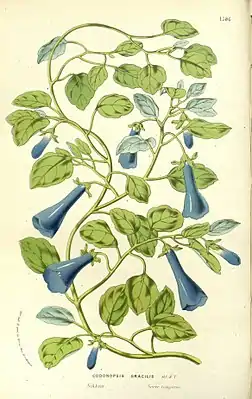Leptocodon
Die Gattung Leptocodon gehört zur Familie der Glockenblumengewächse (Campanulaceae). Sie besteht aus zwei Arten, die im Himalaya verbreitet sind.
| Leptocodon | ||||||||||||
|---|---|---|---|---|---|---|---|---|---|---|---|---|

Leptocodon gracilis, Illustration | ||||||||||||
| Systematik | ||||||||||||
| ||||||||||||
| Wissenschaftlicher Name | ||||||||||||
| Leptocodon | ||||||||||||
| (Hook. f.) Lem. |
Merkmale
Von den Gattungsmerkmalen her ähnelt Leptocodon der Gattung Codonopsis, der Fruchtknoten ist an der Spitze jedoch mit fünf Drüsen besetzt, die versetzt zu den Staubblättern stehen. Die Blüten sind fünfzählig. Der Pollen besitzt sieben bis acht Furchen („colpat“).[1] Der Fruchtknoten ist dreifächrig, der Griffel ist dreilappig. Die Frucht ist eine ledrige dreifächrige Kapsel.
Ökologie
Leptocodon kommt in schneefreien Gebieten vor. Die Samen haben jedoch eine feste Keimruhe.[2]
Systematik
Die Gattung Leptocodon gehört zu den Glockenblumengewächsen im engeren Sinne (Campanuloideae) und wird dort in eine Verwandtschaftsgruppe mit Campanumoea, Canarina, Codonopsis, Cyananthus, Ostrowskia und Platycodon gestellt.[3] Auf Grund dessen, dass die Gattung lediglich durch die Drüsen von Codonopsis unterschieden wird, plädieren Morris & Lammers (1997) dafür, Leptocodon in diese zu integrieren.
Arten
Es gibt zwei Leptocodon-Arten, die aber von manchen Autoren zu Codonopsis gestellt werden[4]:
Literatur
- J. D. Hooker & T. Thomson: Dr. Hooker and Dr. Thomson's Praecursores ad floram indicam - Campanulaceae In: Journal of the Linnean Society 2/1858, S. 17
- K. E. Morris & T. G. Lammers: Circumscription of Codonopsis and the allied genera Campanumoea and Leptocodon (Campanulaceae: Campanuloideae). I. Palynological data. In: Botanical Bulletin of the Academia Sinica. 38/1997, S. 277–284: Online
Einzelnachweise
- K. K. Shresta & V. F. Tarasevich: Comparative pollen morphology of genus Cyananthus in relation to its systematics and its position within the family Campanulaceae In: Bot. Zurn. 77(10)/Oktober 1992, S. 1–13
- T. V. Shulkina, J. F. Gaskin & W. M. M. Eddie: Morphological studies towards an improved classification of Campanulaceae s. str. In: Annals of the Missouri Botanical Garden 90/2003, S. 576–591
- W. M. M. Eddie, T. Shulkina, J. Gaskin, R. C. Haberle & R. K. Jansen: Phylogeny of Campanulaceae s. str. from ITS sequences of nuclear ribosomal DNAIn: Annals of the Missouri Botanical Garden 90/2003, S. 554–575
- Rafaël Govaerts (Hrsg.): Leptocodon. In: World Checklist of Selected Plant Families (WCSP) – The Board of Trustees of the Royal Botanic Gardens, Kew, abgerufen am 10. Februar 2018.